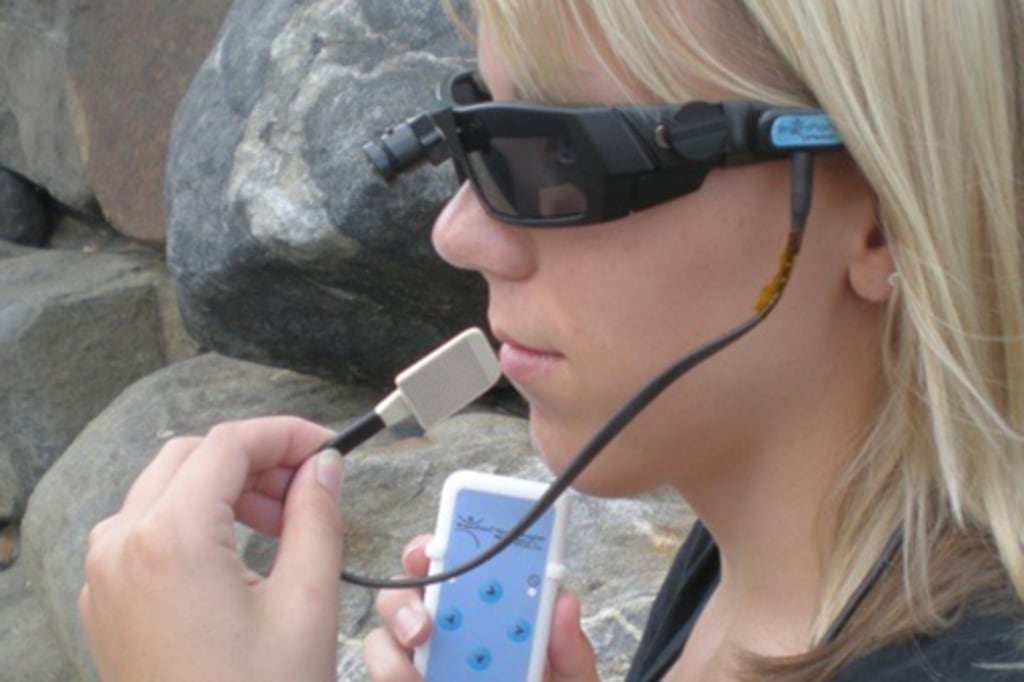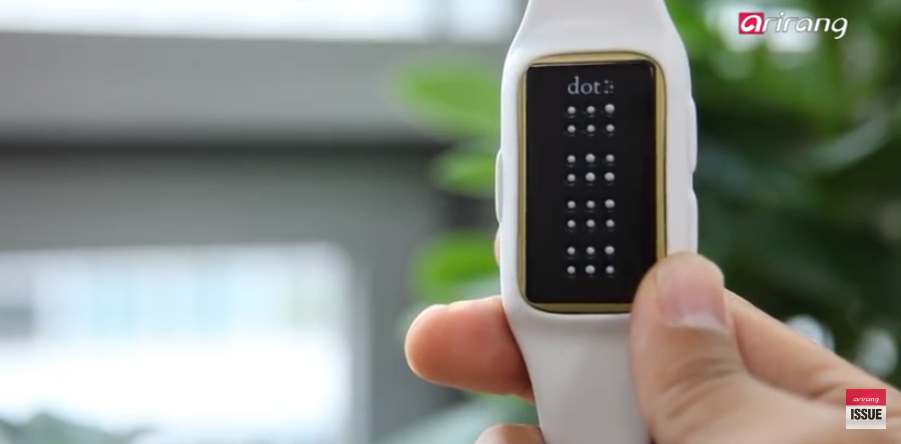Discover Cutting-edge Tools Made for the Visually Impaired
The growth of innovative tools for the aesthetically impaired represents a significant advancement in accessibility and freedom. Technologies such as clever glasses with AI capacities and mobile applications developed to provide auditory descriptions are improving daily experiences for users. Furthermore, wearable devices that use haptic comments boost ecological understanding, while modern-day Braille innovations offer new methods to involve with message. As these devices proceed to evolve, their effect on the lives of those with aesthetic disabilities elevates vital questions about the future of inclusivity and autonomy in different elements of life. What exists in advance in this technical landscape?
Smart Glasses for Navigation

Smart glasses designed for navigation are reinventing the method visually impaired individuals interact with their setting. These sophisticated devices use a combination of electronic camera innovation, artificial knowledge, and auditory responses to offer real-time details regarding environments. By utilizing barrier detection systems, clever glasses can notify customers to possible risks, allowing much safer mobility in both familiar and strange setups.
The combination of GPS technology even more boosts navigation capacities, allowing customers to receive acoustic instructions as they relocate. This hands-free approach not just cultivates independence however also encourages aesthetically impaired individuals to navigate metropolitan landscapes with raised confidence. Furthermore, several smart glasses are geared up with features that identify spots and road indications, offering contextual details that enhances the individual experience.
In addition, the development of these gadgets is consistently advancing, with companies functioning to enhance the accuracy of object recognition and increase the variety of navigational features. As clever glasses end up being more economical and easily accessible, they hold the possible to dramatically transform day-to-day live for visually damaged customers. Eventually, these cutting-edge tools stand for a crucial step towards inclusivity, offering improved wheelchair and a better feeling of freedom for people navigating the world around them.

Mobile Apps for Daily Living
Just how can mobile applications improve the lives of aesthetically damaged individuals? Mobile applications are transforming the way aesthetically impaired users browse their environments, take care of everyday tasks, and gain access to information. These applications give necessary support via different functionalities, cultivating independence and boosting lifestyle.
Several cutting-edge mobile applications are designed particularly for daily living. For circumstances, apps like Be My Eyes attach aesthetically damaged customers with sighted volunteers through video clip telephone calls, enabling them to obtain real-time assistance with tasks such as reviewing labels or browsing unknown spaces. Seeing AI, created by Microsoft, makes use of artificial intelligence to explain environments, reviewed text, and determine things, effectively transforming a mobile phone right into an effective device for daily aid.
In addition, navigating applications customized for the aesthetically impaired, such as Aira and BlindSquare, offer audio-based directions and ecological details, making it possible for users to traverse their environments securely and confidently. Beyond navigating and prompt aid, mobile apps also sustain organization and task monitoring, with functions that help users establish suggestions, develop to-do checklists, and track consultations. In summary, mobile applications work as important sources, equipping visually impaired individuals to lead more independent and meeting lives.
Wearable Technologies for Help
Empowerment with innovation is progressively apparent in the realm of wearable devices designed to aid aesthetically impaired individuals. These innovative tools integrate seamlessly into day-to-day live, improving navigating and supplying necessary responses to customers. For example, smart glasses geared up with cameras can recognize faces and review text out loud, permitting customers to connect even more confidently in specialist and social setups.
An additional significant development is making use of haptic comments systems in wearable gadgets. These systems use vibrations or various other responsive signals to share information concerning the user's setting, such as challenges or modifications in terrain, improving mobility and safety. Wearable modern technologies likewise include wristbands that attach to mobile phones, alerting users to alerts through subtle resonances, therefore boosting connection without dependence on aesthetic signs.
As these technologies remain to evolve, they are not only boosting self-reliance for visually damaged people but additionally fostering a higher feeling of inclusion in society. By linking the gap between obstacles faced in everyday living and the capacity for freedom, wearable innovations act as pivotal tools in the mission for equal rights and empowerment for those with visual disabilities.
Sound Summary Tools
Audio description devices play a crucial function in improving their explanation access for visually impaired individuals, supplying them with the capacity to engage with visual media. Speech-to-text devices for low vision. These tools offer narrated descriptions of crucial aesthetic components in films, television shows, and live performances, guaranteeing that users can completely comprehend the context and feelings conveyed through visuals
Audio description can be incorporated right into various platforms, consisting of streaming solutions, movie theater testings, and live theater. Numerous prominent streaming solutions currently consist of audio description as an availability attribute, enabling customers to choose it conveniently. Along with conventional media, specialized apps likewise exist, supplying audio summaries for art exhibits, galleries, and various other cultural events.
The efficiency of audio description hinges on the ability of the storytellers, who should convey visual details succinctly without diminishing the original sound. Technologies in this field are also leading the way for even more tailored experiences, where individuals can adjust the degree of detail and pacing according to their choices.
Braille Innovations and Tools
Braille devices and innovations have considerably transformed the way visually damaged people communicate with text and information. Modern developments have led to the advancement of flexible tools that boost proficiency and self-reliance amongst customers.
In addition, mobile Braille notetakers incorporate typical Braille input with modern-day functionalities, promoting note-taking, organizing, and paper editing and enhancing on the move. OCR devices for the blind. These small devices commonly include text-to-speech abilities, linking the space between Braille and acoustic details
In addition, innovative Braille printers have actually arised, allowing individuals to produce Braille tags, papers, and educational materials efficiently. This access promotes greater engagement in academic and professional environments, inevitably promoting inclusivity.
In addition, research study into clever Braille innovations proceeds to broaden. Devices that include synthetic knowledge are being checked out to give real-time navigation assistance and contextual info, enhancing the individual experience in diverse setups. Overall, these developments mirror a commitment to equipping aesthetically damaged individuals with modern technology, ensuring they can quickly accessibility and engage with the globe around them.

Conclusion
The advancement of ingenious devices for the aesthetically damaged significantly enhances independence and quality of life. Smart glasses, mobile applications, wearable technologies, audio summary devices, and Braille innovations collectively empower individuals by offering vital navigation support, environmental understanding, and enhanced analysis experiences. These modern technologies not just foster better incorporation yet additionally advertise freedom in everyday activities, ultimately contributing to a more accessible and fair culture for visually impaired individuals. Continued advancement in this field holds guarantee for further improvements.
As smart glasses come to be more available and budget friendly, they hold the possible to substantially transform everyday life for aesthetically impaired customers. Mobile apps are revolutionizing the method aesthetically damaged users navigate their settings, manage everyday tasks, and accessibility details. Apps like Be My Eyes link navigate here aesthetically impaired customers with sighted volunteers via video phone calls, permitting them to receive real-time assistance with tasks such as checking out tags or navigating click this link strange rooms.Additionally, navigating apps tailored for the visually impaired, such as Aira and BlindSquare, supply audio-based directions and ecological details, enabling users to traverse their surroundings safely and confidently.The development of ingenious devices for the visually impaired significantly enhances independence and quality of life.
Comments on “Smart Glasses for the Visually Impaired: Advances in Vision Support”